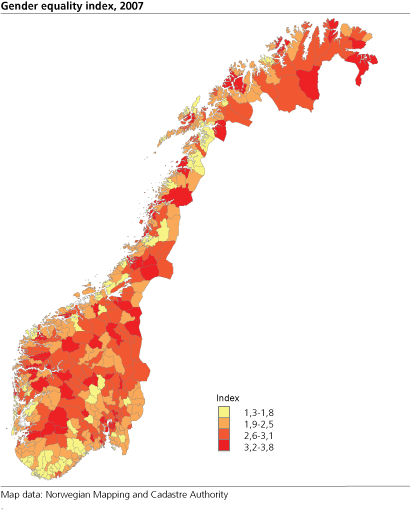Content
Published:
This is an archived release.
Women and men in Tromsø most equal
The gender equality index for 2007 reveals considerable differences between Norwegian municipalities. Women and men in Tromsø are most equal, followed by Namsos in Nord-Trøndelag. On county level, Oslo and Akershus have the highest score, while Vest-Agder, Aust-Agder and Møre og Romsdal have the lowest score.
With a score of 3.83 points, Tromsø has the highest score, closely followed by Namsos in Nord-Trøndelag, with 3.75 points. At the bottom of the ranking are Herøy (Møre og Romsdal) and Farsund (Vest-Agder) with 1.3 points, closely beaten by Selje (Sogn og Fjordane) and Marnardal (Vest-Agder).
Norway’s five largest cities, Oslo, Bergen, Stavanger, Trondheim and Kristiansand all have scores above the national average of 2.5 points.
Oslo and Akershus with highest score
Women and men in the southern-most counties are least equal. Vest-Agder is ranked lowest with 1.9 points followed by Aust-Agder with 2.2 points.
Oslo and Akershus counties have the highest score with 3.0 points. Almost all municipalities in Akershus are above the national average. The counties of Sogn og Fjordane, Finnmark, Buskerud and Nord-Trøndelag also achieve high scores.
Many ways to describe gender equalityThe gender equality index combines various direct and indirect indicators of gender equality that show the extent to which women and men participate in politics, education and working life. The indicators are: Kindergarten coverage for children aged 1-5 (2006) Number of women per 100 men aged 20-39 (2006) Education levels for women and men (2006) Labour force participation for women and men (2006) Income for women and men (2006) Percentage of female municipal council members (2007) The tables contain more detailed information and enable users to compare counties and municipalities by individual indicators and as a total. "About the statistics" contains information on how the index is estimated. |
Tables:
- Table 1 Gender Equality Index for Norwegian municipalities, sorted by county. 2007
- Table 2 Gender Equality Index for Norwegian municipalities, by ranking. 2007
- Table 3 Gender Equality Index for Norwegian municipalities, ranked by county. 2007
- Table 4 Gender Equality Index for Norwegian municipalities, data. 2007
Additional information
The indicators of gender equality in municipalities has been published every year since 2008. The indicators are based on available statistics from registers, and measure gender equality in all municipalities and counties, as well as average for the whole country.

